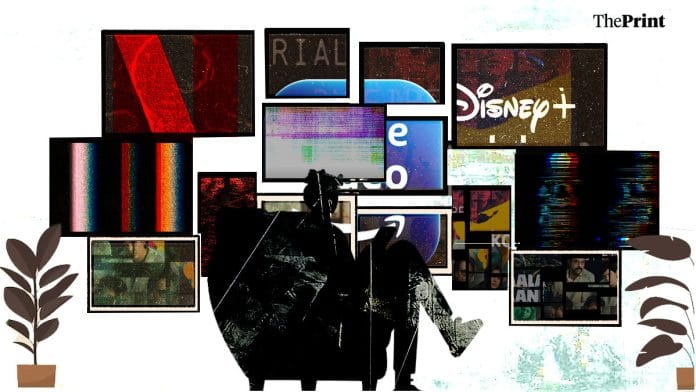New Delhi: India’s OTT industry is staring at a massive slump. It is, in fact, immobilised. Once bursting with fresh faces and bold scripts, it now feels like the B-team of Bollywood, recycling big stars and safe stories. And not very many of those either—since 2023, nothing major has been commissioned by OTT platforms.
“Production is down to almost one-fifth of what it used to be,” said Pranjal Khandhdiya, producer and head of Outsider Films. “There was a time when 17 shows and films would release on a weekend and you would be spoilt for choice. Now, there’s barely one in a month.”
The golden age of OTT storytelling has hit a wall. Where these platforms were once havens for original, offbeat content and overlooked talent, their offerings now look like an extension of theatrical releases, except in episodic format. The same platforms that gave us Mirzapur’s ruthless Kaleen Bhaiyya or Kota Factory’s inspiring Jeetu Bhaiya are now running after star power and studio deals.
Not so long ago, OTT platforms like Amazon Prime Video and Netflix in India were called “gamechangers”. They shrugged at big names and spotlighted strong scripts and solid acting. But that seems like a distant memory. In the past two years, there have been more stars and less acting. It’s like a replay of the sad fate of 90s’ cable TV —which started out with thought-provoking content for every section of society, but dissolved into the melodrama and smudged mascara of saas-bahu shenanigans post Ekta Kapoor’s success with the genre in the 2000s. Except now, instead of domestic drama, OTT’s ‘safe’ bet seems to be crime thrillers set in the hinterlands.
“Nine out of 10 executives have no clue about the creative aspect of the business. They have not really taken risks or showed conviction. They are ‘yes men’ and chase after those 10 stars. You see it now on OTT as well,” said Navjot Gulati, writer and director of films like Ginny Weds Sunny (2020).
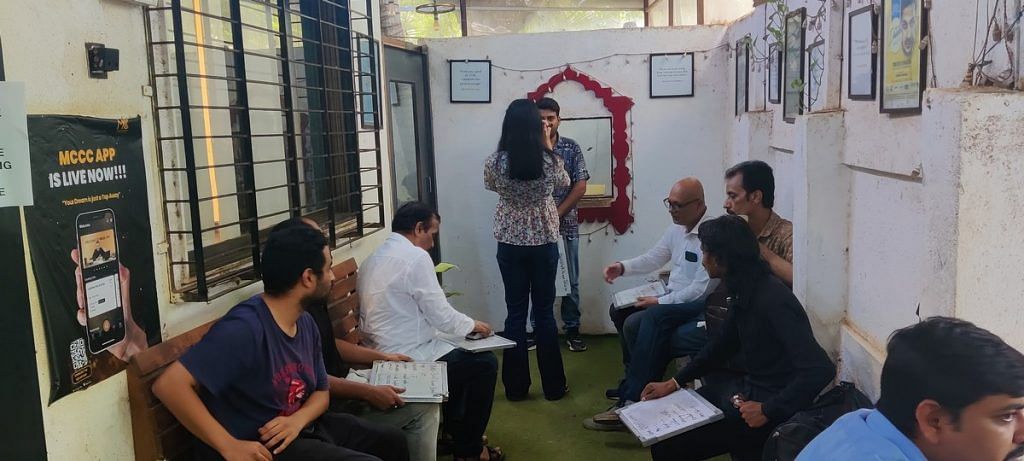
Now, with few new projects being commissioned, writers, technicians, and actors are struggling to make ends meet.
“Many new production houses and producers were functioning like brokers and just facilitating deals between OTT channels and stars or other production houses—it became about making a quick buck, especially around Covid,” said Rahat Jain, a film director. “But that money has now dried up, and now, no one wants to risk it. So, there are no new projects, especially for newcomers.”
Now, OTT platforms rely on ‘bankable’ stars or influencers with massive followings. Scripts deemed too political, controversial, or even ‘women-centric’ are quickly struck off the list.
Also Read: Panchayat to Laapataa—villages on OTT are Gandhian simplicity or Ambedkar’s den of ignorance
Shelved projects, self-censorship
A hackneyed formula has gripped OTT. Everyone is churning out crime or espionage, whether in fiction or documentary format. But this seems to be less about audience demand than self-censorship.
“If nothing else works, just throw a Mumbai mafia don story for nostalgia, or make the Pakistanis the bad guy. It is as formulaic as it gets,” said an independent filmmaker. “No one wants to take a chance or has the conviction to push for something new, unless it has a big Bollywood face.”
Akshay Kumar spelled doom for OTT. All these platforms bought his films for a massive amount of money, and now the cash flow to do anything else has dried up
-Navjot Gulati , filmmaker
No one seems to want to bet on historical dramas or even slice-of-life stories—genres with a history of ‘offending’ the government or fringe groups. Even family dramas have receded into the background. Now, some established TV shows are just imported to OTT—like The Kapil Sharma Show to Netflix.
As many as 20 projects are on hold, said a producer who was involved in several OTT series in India—and everyone is running from pillar to post, trying to get productions started.
“Given the atmosphere where just about anyone gets offended, the OTTs are literally walking on eggshells and indulging in self-censorship. The outcome is films and series based on a narrow range of subjects,” said actor Danish Husain, who has appeared in OTT series such as Bombay Begums. “Dependence on bankable faces and studio interference in the creative process is constricting spaces for independent and critical voices.”
In recent years, the fear of government censure has only grown, with several high-profile controversies.
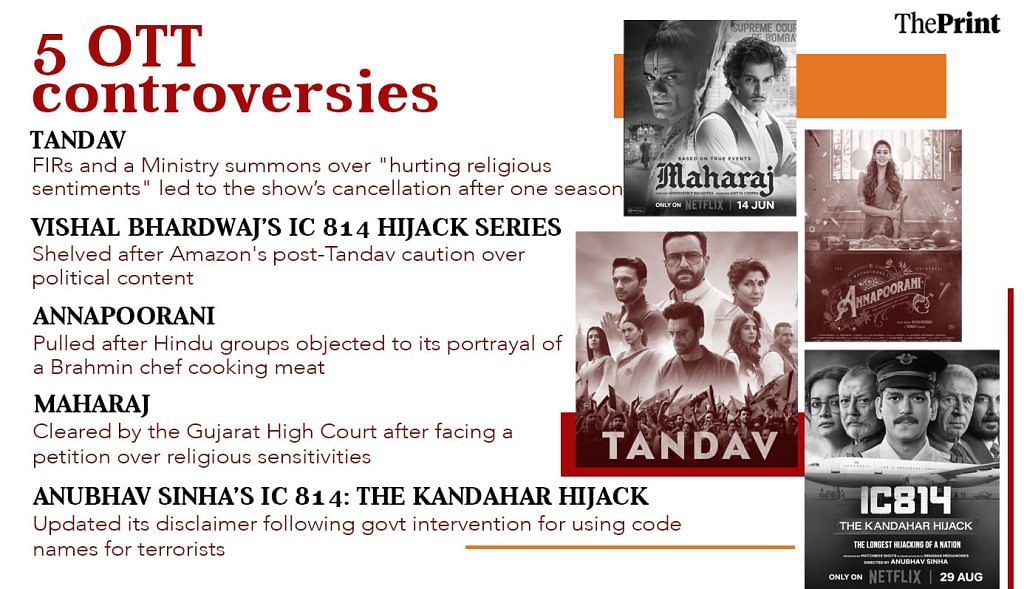
It started with Amazon Prime Video’s Tandav (2020), a thriller series about student politics, starring Saif Ali Khan, Mohammed Zeeshan Ayub, and Sarah-Jane Dias. The show was hit with FIRs, relentless trolling, and a Ministry of Information and Broadcasting (I&B) summons for allegedly ‘hurting religious sentiments.’ The ‘controversial’ sequences featured Ayub as Lord Shiva in a college play, discussing ways to build a social media following that could rival Lord Ram’s. Despite an apology from the makers, the second season of the show was axed.
Tandav’s fate sent a chilling message, prompting Amazon Prime Video to pull the plug on other potentially ‘risky’ content, including Vishal Bhardwaj’s show on the 1999 hijacking of Indian Airlines flight IC 814.
“They were so paranoid, they still are, that they didn’t want to touch anything political,” Bhardwaj later said. He also claimed that his screen adaptation of The Exile: The Flight of Osama Bin Laden was shelved for the same reason.
But content doesn’t have to be overtly political to be deemed ‘offensive’. In January, Netflix removed Nayanthara-starrer Annapoorani from its platform after Hindu groups alleged it was “anti-Hindu” and filed an FIR. Zee Studios, one of the producers, wrote an apology to the Vishwa Hindu Parishad, stating that the film—about a Brahmin chef who cooks meat— would stay off the platform until edited.
In June, Netflix also faced legal heat for Maharaj—a pre-independence historical drama starring Junaid Khan and Jaideep Ahlawat—when followers of the Vaishnavite Pustimarg sect filed a petition against the film. It was finally granted relief by the Gujarat High Court and released on 21 June.

The latest flashpoint is Netflix’s IC 814: The Kandahar Hijack, directed by Anubhav Sinha. This take on the 1999 hijacking faced backlash from the government and the public. BJP information cell chief Amit Malviya accused the show of “whitewashing” the terrorists’ religion by using code names like ‘Chief,’ ‘Doctor,’ and ‘Bhola’ instead of their real names. Netflix India’s content chief, Monika Shergill, was summoned by the I&B Ministry, and the show then updated its disclaimer to include both the real and code names of the hijackers.
OTTs are in “a state of paralysis” because of three big developments, according to Husain. First, they were waiting for the general elections to see if the political landscape shifted. Then, they wanted to see the direction of the new broadcast bill— which, incidentally, extended regulatory oversight to OTT platforms and came with a ‘censorship clause’. And finally, the industry also expected major consolidations—Sony and Zee’s (failed) merger, as well as Jio’s takeover of Disney+ Hotstar.
“All these put them (OTTs) in a directionless spot for some time now,” Husain said. “The summoning of Netflix’s IC 814 makers by the ministry isn’t helping either.”
ThePrint contacted Netflix, Amazon Prime, and Sony Liv for comment via email. While all three listed their upcoming projects, they did not provide data on when these projects were commissioned or when they would be completed. They also didn’t comment on the OTT downturn.
Shift to the ‘safe’ lane
Between censorship fears and the influx of new competitors, OTT platforms are jostling for space. Regional players are biting into the pie, while traditional subscription models are losing ground to ad-based alternatives. It’s no longer just about high-quality content—it’s about who can survive the squeeze.
One fast-growing advertisement-based platform is Amazon miniTV, which cranks out short, snappy shows. With unknown faces and bite-sized narratives, these shows are cheaper and quicker to produce and rake in revenue through targeted ads—something subscription models can’t do. It’s targeting the 18-34 age group, and offering free content to all Amazon users, Prime membership or not.
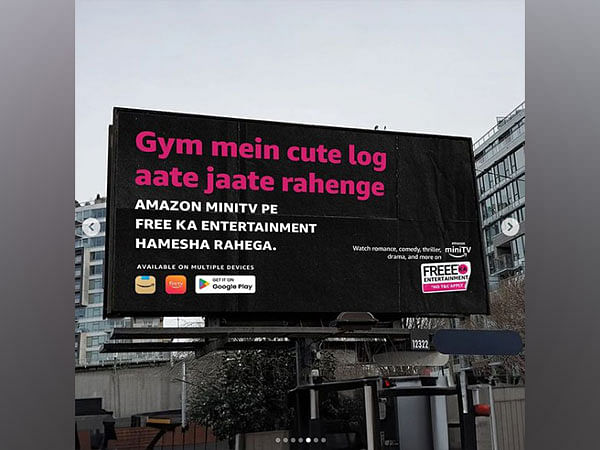
OTT platforms rely on subscriber data from media trackers like Ormax to figure out what’s trending. According to a screenwriter who has written for Indian OTT shows, the young adult market is where the action is and studio executives are trying to leverage this.
“That is why you see a lot of young adult shows on Amazon miniTV,” said the screenwriter.
Then, there’s also a race to capture untapped, rural audiences.
In 2023, OTT viewership grew by 13.5 per cent, reaching 481.1 million people, up from 423.8 million in 2022. However, penetration in rural areas and small towns, which make up a major chunk of the population, stands only at 23 per cent, compared to the pan-India figure of 34 per cent.
The problem is herd mentality. Once a certain kind of movie becomes a hit, everyone will immediately make some version of it. The catchphrases since 2023 have been ‘100 crore idea’, ‘pan-India feel’, ‘500 club entry’—these are what people say when pitching ideas
-Pranjal Khandhdiya, producer
This struggle to break into rural and Tier 3 and 4 markets has fuelled the rise of ‘massy’ content, often mimicking the formula of TV shows. And, as industry insiders point out, meaningful content has taken a backseat.
“What level of execution is present in the content currently being produced on OTT platforms? And who are these content producers? What knowledge do they possess? Do they have a grasp of our epics and literature? My point is that they don’t,” bemoaned filmmaker Prakash Jha in an interview a few months ago.
The shift toward ‘masala’ formulas is evident in recent OTT collaborations. Netflix has partnered with Yash Raj Films on three upcoming projects, kicking off 2024 with Sanjay Leela Bhansali’s Heeramandi, a big-budget series starring Bollywood names like Sonakshi Sinha.
Amazon Prime also launched the year with the high-profile but critically trashed Indian Police Force, directed by Rohit Shetty and starring Sidharth Malhotra and Shilpa Shetty. And one of its latest offerings, the frothy comedy Call Me Bae, is produced by Dharma Productions and headlined by Ananya Pandey.
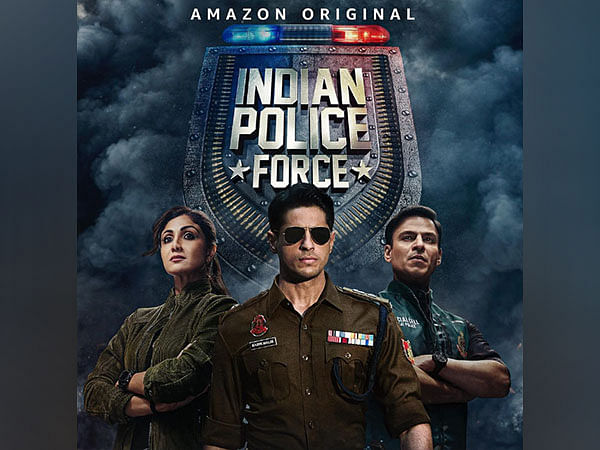
Star ‘power’, cash drain
One of the things nearly everyone lauded OTT for was the ‘end’ of star culture. Some of the biggest hits in recent years rode on good scripts and unknown faces—from Prime Video’s Mirzapur and Paatal Lok, to Netflix’s Jamtara and Mismatched, to Sony Liv’s Rocket Boys.
But that has changed. The tide began to turn with theatrical releases, and OTT platforms quickly followed suit.
What changed the game for theatrical releases was Shah Rukh Khan’s Pathaan (2023), which crossed the Rs 1,000 crore mark worldwide and became one of the highest grossing films of the year. Pathaan’s success reignited the demand for star-driven content in cinema. Big-budget, big-name films like Rocky Aur Rani Kii Prem Kahani, Jawan, and Animal came on its heels. And OTTs weren’t far behind.
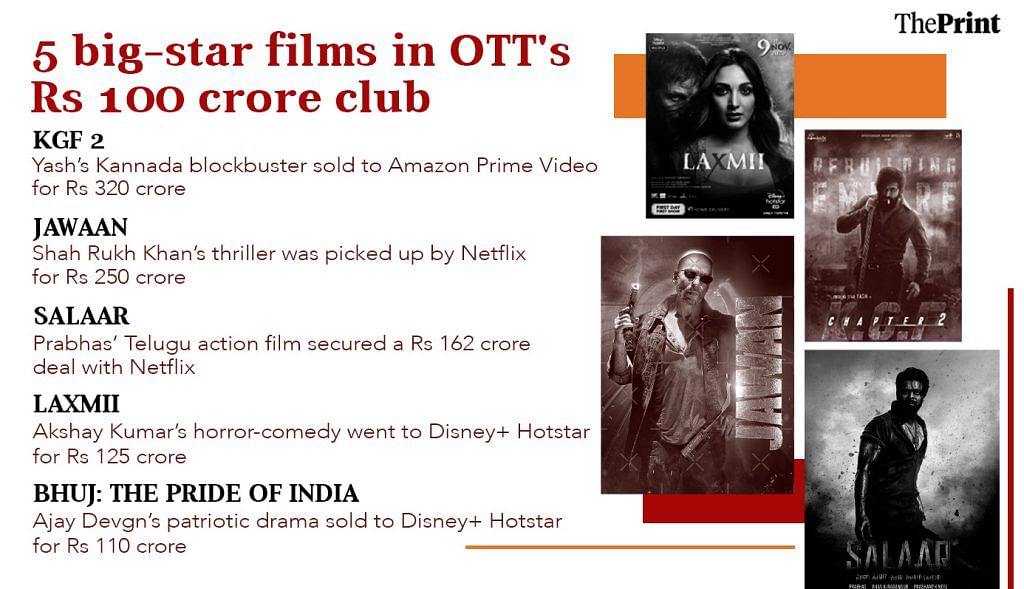
“The problem is herd mentality,” said producer Pranjal Khandhdiya. “Once a certain kind of movie becomes a hit, everyone will immediately make some version of it. The catchphrases since 2023 have been ‘100 crore idea’, ‘pan-India feel’, ‘500 club entry’—these are what people say when pitching ideas.”
This herd mentality has now spilled over to OTTs too, where production houses are going for formulas they think will yield the best viewership. OTT content has now become all about cuss words, sex, crime, or national security threats—whatever has proven to drive numbers.
Filmmaking has become a business and this has damaged the industry, according to filmmaker Prakash Jha.
“When satellite channels offer Rs 400 crore to actors like Ajay Devgn or Akshay Kumar, then money becomes the keyword. You start buying rights to films from other languages, get the director too, and with the impetus to make money, and turnover pressure, these films are being made,” he said in Hindi during the same interview quoted earlier.
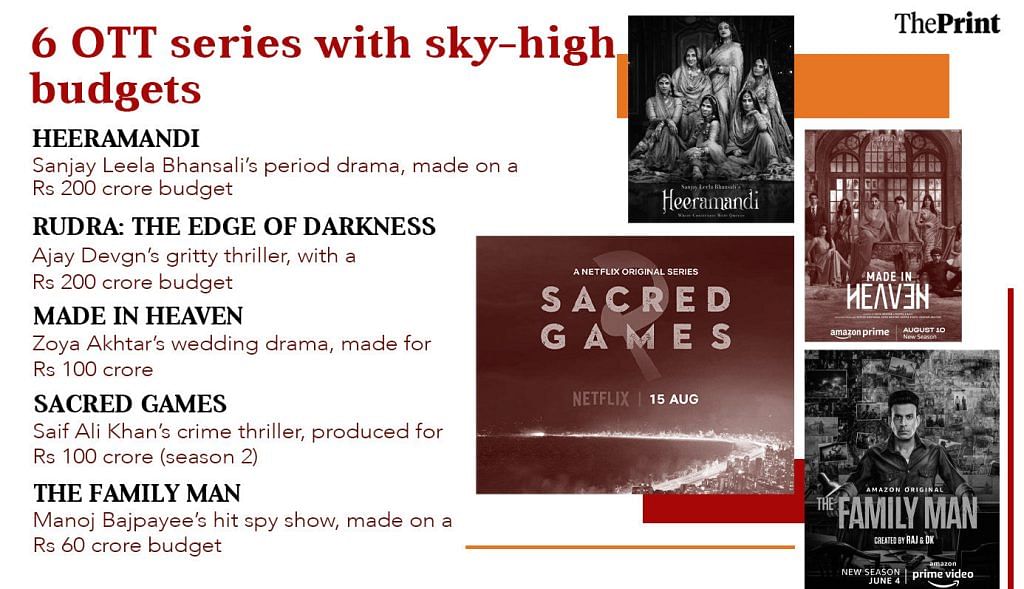
The impact of theatrical releases can be felt on OTT platforms too. Earlier, satellite TV would buy theatrical releases, but now OTTs fulfill that role. And with extortionate multiplex ticket prices, more people prefer to wait for big-screen films to land on OTT platforms. This has helped some small-budget films, like Laapata Ladies, which beat Animal on Netflix to become one of the most streamed movies.
But when OTT platforms buy big budget, star-studded films, the risks are higher and the returns way lower.
Filmmaker Navjot Gulati pointed out that an over-reliance on stars is draining OTT platforms.
“Akshay Kumar spelled doom for OTT. All these platforms bought his films for a massive amount of money, and now the cash flow to do anything else has dried up,” he said. Gulati noted that stars like Kumar continue to profit and have their films bought by OTTs, even if they deliver flops.
In 2020, Hotstar reportedly bought Akshay Kumar’s unreleased film Laxmii for a direct to digital release for Rs 125 crore, a decision Gulati questioned.
“Did the spending garner new subscribers? If there are no new subscribers, how does the OTT platform earn money?” he asked.
This business model is also evident in the case of Ajay Devgn, whose recent films—apart from Drishyam 2 and Shaitaan— have sunk without so much as a ripple. Yet, for the web series Rudra, a remake of Luther, he charged Rs 21 crore per episode, pushing the show’s budget to Rs 200 crore.
There’s no evidence that these decisions have generated revenue or new subscribers. Instead, industry sources say platforms are merging—like Hotstar with Jio Cinema—to cope with rising costs and increased competition, especially after previous overspending.
Regional rejection
Even as OTT platforms pour money into big stars, regional and independent projects are left in the cold. Even films that win state or national awards face an uphill battle to get picked up. Producers of small-budget, critically acclaimed projects often find themselves stuck in endless meetings with OTT executives, usually with little to show for it.
“I was asked by an OTT executive who the star of my show is, and if audience members will recognise an Assamese actor,” said one Assamese producer. He was even asked if he would consider making his series in Hindi instead of Assamese.
If we are constantly worried about payments and generating work for ourselves, there won’t be out-of-the-box thinking even at the script stage. Risk is not a writer’s game—producers, executives, and studios have that mandate
Anu Singh Choudhary, screenwriter
A National Award-winning Malayalam director echoed the same struggle.
“You have to go through multiple meetings only to get rejected because they do not ‘know’ who the lead of the film is. That’s because they do not watch anything but commercial output,” he said.
At the end of the day, the adage ‘content is king’ doesn’t seem to hold true for OTT platforms.
“People with spending power want to pin their hopes on stars instead of scripts or someone’s imagination. Investors want money, and OTT are now investing in stars. And even they are failing,” said filmmaker Sudhir Mishra.
Sony Liv is one of the few platforms that offers a balance of Hindi and regional content within the same subscription package. Amazon Prime, meanwhile, has tie-ups with platforms like Manorama Max and Lionsgate Play, though accessing newer content requires paying an additional Rs 200 or more.
Also Read: Male gaze has met its match. Women writers are rewriting Bollywood, Aarya to Rocky Aur Rani
Writers’ woes
When the pandemic hit, people turned to their laptops and TVs for relief. India was introduced to the likes of Mirzapur’s Kaleen Bhaiya, Aarya’s titular anti-heroine, the students of Kota Factory, the police inspectors of jamunapaar Delhi in Paatal Lok, and many other memorable characters.
Such was the boom in screenwriting that people gave up high-paying, stable jobs to try their luck in writing. OTT-writing workshops emerged and writers’ names appeared in the credits. And briefly, just briefly, it appeared like a golden era was on its way.
But writers are among the worst hit by the slowdown in OTT. There’s unanimous agreement that work has significantly dried up, and payments are often delayed.
“If we are constantly worried about payments and generating work for ourselves, there won’t be out-of-the-box thinking even at the script stage. Risk is not a writer’s game—producers, executives, and studios have that mandate,” said screenwriter and author Anu Singh Choudhary.
Even experienced writers struggle to get work and timely payment, with some even putting their dreams on hold.
“I had to take a regular job because writing was not paying. I wrote for whatever came my way—ads, YouTube videos. After all, one has to pay rent and survive in Mumbai,” said one screenwriter, a Film and Television Institute graduate with a popular OTT show to her name.
Two of her films, signed in January 2023, were dropped by July that year. By then, she knew she had no choice but to look for a job. And it wasn’t just about the lack of work—she was also asked to be “less feminist” or change the age of her female protagonist when pitching scripts to network heads.
“Some of the comments were, ‘Can you make your protagonist 25ish? Actually, can you make this character male?’. This was not even feedback about my writing,” she said.
By this time, OTTs had turned away from female-led shows. Budgets were slashed, and some productions were stopped midway.
“With all these pan-Indian, hyper-masculine films, OTT too now wants similar content,” she said.
It’s no surprise that much of OTT content now revolves around crime or hinterland stories.
“Add a few cuss words and a sex scene, and literally every other show is starting to look just the same on OTT. It’s just like the saas-bahu trope in the 2000s—running after ‘massy’ was the death of TV, and we are heading in that direction here too,” said Khandhdiya.
And no one seems to have cracked the code for Gen Z content.
“They don’t want to see 50-year-olds romancing women half their age. They call this out,” Khandhdiya added. “And if OTT goes the same way, then Gen Z would rather spend time on Instagram and 30-second reels.”
(Edited by Asavari Singh)



